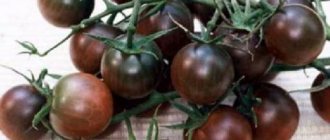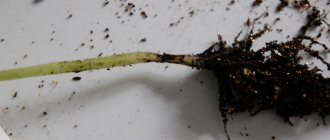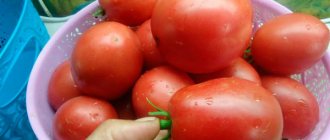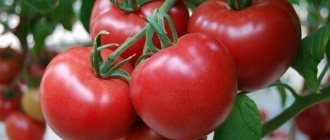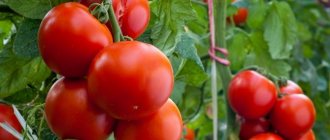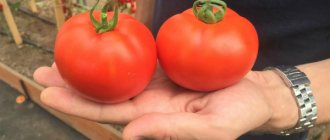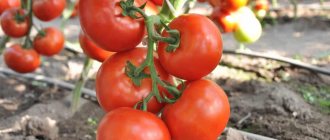A tomato with the perky name “Hali-Gali” appeared relatively recently. It was bred by Siberian breeders at the beginning of this century by direct crossing of two parent varieties (“F1”). In 2008, the hybrid was entered into the State Register of Breeding Achievements of the Russian Federation. Hali Gali has established itself as an early ripening and high-yielding variety, with high resistance to various diseases. Excellent keeping quality is noted, which allows the tomatoes to be used for canning, transportation and fresh consumption.
Reviews about this tomato are quite contradictory: some were delighted and plant the seeds every year, while others were left indifferent. To verify or refute these opinions, read the prepared material dedicated to the young hybrid Khali Gali.
Description
The “Hali-gali” tomato bush is a determinate variety. The “Hali-gali” variety can be grown both in open and closed ground. This variety is grown on both small and large scales.
"Hali-gali" refers to early ripening varieties. The fruits are round in shape and have thick skin. By the time of ripening, the fruits weigh approximately 150 g. They are suitable for processing and fresh consumption. The taste characteristics are excellent.
From one hectare of land planted with this variety of tomatoes, approximately 500 centners of harvest can be harvested. If these figures are converted into percentages, the yield will be 80%. Such results became possible due to the fact that breeders worked on the variety’s resistance to fungal diseases. The ripening period of a tomato is about 3 months.
Due to the fact that the fruits have a thick skin, they are not afraid of long transportation. For a long time, tomatoes retain their taste and appearance.
The height of the bush reaches approximately 80 cm. The leaf size is medium and the color is light. The first inflorescence appears on the seventh leaf. There is a point at the top of the bush. It is worth noting that the yield of “Hali-gali” largely depends on where the tomato was planted: in open or closed ground. So, in a field with 1 m2 of land on which bushes are planted, you can collect about 9 kg of fruit. If you plant “Hali-gali” tomatoes on 1 m2 of land in a greenhouse, you can harvest up to 13 kg of harvest.
Sowing of seeds should be carried out 3 months before planting at a permanent place of cultivation. You can count on the development of a healthy bush only if the air temperature outside or in the greenhouse reaches about 25C. Seedlings should be planted at a distance from each other of approximately 50 cm. The bushes need fertilizing and agrotechnical work.
Important! Determinate tomato varieties should be grown with support.
Timely garters and shaping of stems will allow you to get a bountiful harvest. Pinching is an important stage of cultivation, which helps to increase productivity.
Landing
Work with seedlings begins in early spring. The “Hali-Gali” variety is a hybrid variety, so it will not be possible to independently extract seeds from the fruits of the previous harvest. You should buy seeds in a store, and contact only trusted suppliers. At the next step, a ready-made earth mixture is purchased, or soil from the garden is mixed with humus.
Prepared and disinfected containers are filled in several layers. The first is expanded clay, which acts as drainage, the second is already watered soil. Holes are dug to a depth of 1 centimeter, and seeds are placed there. Then the plantings must be wrapped in plastic wrap and left in a lighted space where the temperature is maintained at approximately 23-34 degrees Celsius. When sprouts appear, the film will need to be removed and the containers moved to a space with a temperature varying from 17 to 19 degrees.
During the seedling period, it is very important to provide the tomatoes with sufficient light for 12 hours. If the region is cloudy, then you will have to do this yourself
In addition, it is important not to forget about regular watering.
The appearance of two leaves on the plants will mean the beginning of the diving period, and after two months have passed from the start of work, it will be time to transplant the seedlings into the ground.
For tomatoes, you need to prepare well-lit areas with nutritious soil on the south side of the site. “Hali-Gali” cannot be planted in a place where other nightshades used to grow, but it can be planted in former beds of beans, onions or cabbage. In theory, you can plant several varieties of tomatoes in one bed. “Going outside” is allowed only when the frost ends. For open ground this means the end of May - beginning of June, and for closed ground - two weeks earlier.
Planting occurs as follows: the ground must first be warmed up so that the soil temperature reaches 15 degrees Celsius. At the same time, you can disinfect it with a solution of potassium permanganate. Several rows are formed, the distance between which is 50 centimeters. Between the plants themselves you will have to maintain a gap of 40 centimeters. You cannot place more than 6 bushes per square meter. The sprouts are immersed in the ground strictly vertically along with the soil clod. After planting is completed, “Hali-Gali” will have to be watered thoroughly.
Advantages and disadvantages
Among the positive aspects of “Hali-gali” tomatoes, we note the following:
- Resistance to unstable temperatures.
- Resistant to lack of moisture, so “Hali-gali” can be grown even on the balcony.
- It contains a large amount of sugar, so even children like it.
- An early ripening variety that bears fruit for three months.
The only disadvantages are the need to regularly feed the bushes and the relatively low yield.
Sowing seeds for seedlings
Due to the small height of the bush, these tomatoes can also be grown on the balcony. The variety is grown by seedlings.
Optimal timing
“Hali-Gali” is a hybrid variety, which means that seeds must be purchased for each sowing. Sowing is carried out in late February or early March.
Did you know? In Greece, on the island of Santorini, on the territory of a former factory that produced tomato paste, there is a museum telling the history of fruit processing. The story begins with the transportation of crops on donkeys from a plantation, and ends with the loading of goods onto ships for transport by sea.
Soil mixture
Properly selected components of the soil mixture are the key to healthy seedlings and rapid rooting. Tomatoes love nutritious, but not excessive, soil with neutral acidity. The soil must be loose to provide the roots with access to air and moisture.
A suitable mixture can be made up of the following components (proportions 1:2:1:0.5):
- garden soil;
- peat;
- mature compost;
- river sand.
Growing container
It is preferable to sow tomatoes in peat tablets, which for convenience should be placed in a common box. In any case, the planting container must be washed and doused with boiling water.
Seed preparation
Typically, purchased planting material undergoes stimulating and disinfecting treatment during production. To be more confident, you can soak the seeds in a slightly pink solution of potassium permanganate for 2–3 hours. Then dry and place in a growth stimulator (Epin) for half an hour.
Find out why tomatoes in the greenhouse do not turn red and what to do about it.
Sowing seeds
The seeds are planted at the same distance from each other, in slightly moistened soil. Sowing depth - 2 cm. After the seeds have been sprinkled with soil, spray them and cover with film. Before germination, the box should be placed in a shaded place, the germination temperature is 22–25 °C.
Seedling care
After the sprouts appear, the shelter is removed and the box is placed on a rack placed near the window (here the temperature should be 17–20 °C). The rack must be equipped with artificial lamps to provide the seedlings with 12 hours of daylight.
During the growing season, seedlings need moisture, so watering is carried out regularly, preventing the soil from drying out. When the seedlings reach a height of 5 cm, they are planted into separate containers. The first 5 days after picking, watering is not carried out, as the plant must adapt.
Before picking, the seedlings do not need to be fertilized, but many vegetable growers water the seedlings with a copper solution, which prevents late blight. To do this, dilute 1 teaspoon of concentrated copper microfertilizer in 10 liters of water and water the sprouts at the root.
The first fertilizing a week after picking can be done with yeast fertilizer:
- live yeast - 10 g;
- sugar - 4 tablespoon;
- water - 100 ml;
- Dilute the resulting concentrate with boiled water 1:10.
Hardening of seedlings
Seedlings must be hardened off so that in open ground the roots of the plant do not get stressed by temperature changes. 10–14 days before planting, pots with tomato seedlings are taken out onto the balcony or veranda. On the first day, the seedlings are left in the air for half an hour, then the time is increased every day. As a result, in the last days before planting, tomatoes spend 24 hours outside.
Did you know? Artist Andy Warhol's painting "Campbell's Tomato Soup Can" was sold at Sotheby's in 2006 for $4,900,000.
Diseases and pests
Another characteristic feature of “Hali-gali”, for which the variety has found its fans among gardeners, is resistance to diseases. To further strengthen the plant’s immunity to diseases and pests, it needs to be looked after. This includes timely watering of the bushes, ventilation of the greenhouse if tomatoes are grown indoors, loosening the soil and providing the greenhouse with sufficient lighting.
Khali-gali tomatoes are vulnerable to thrips and melon aphids. To combat them, gardeners most often use a special preparation “Bison”. If you grow tomatoes in open ground, they may be spoiled by the Colorado potato beetle. To get rid of the pest, you can use the drug “Prestige”.
How to care for a tomato
| Stage 1. Planting seedlings Step 1. Apply fertilizer to the tomato plot. Use rotted manure or compost at the rate of a bucket per square meter. Dig up the area to a depth of at least 20 cm. Step 2. Make holes for the plants according to a 50x40 cm pattern. Carefully remove the seedlings from the container and transplant them into the prepared holes. Fill with soil, compact the surface and water thoroughly | |
| Stage 2. Watering Step 1. Prepare the water in advance. Pour it into containers at least a day in advance and keep it in a greenhouse or near a garden bed. Step 2. Water the tomatoes as the soil dries, usually once a week, a little more often during hot periods. Optimal time: evening after sunset | |
| Stage 3. Weeding and loosening Step 1. Weed your tomato bed once a week. It is much easier to remove weeds while they are still small. Step 2. Loosen the surface around the stems after each watering. If the bed is on open ground, then loosen it after rains | |
| Stage 4. Feeding Step 1. Purchase a special complex composition for tomatoes. It contains all the necessary substances and microelements for the growth and abundant fruiting of plants. Step 2: Apply fertilizer every 3-4 weeks. Plants especially need feeding during the fruiting period. | |
| Stage 5. Tying Option 1. Secure a crossbar over the plants and tie pieces of twine to it. The cord is carefully tied to the bottom of the stem so as not to crush it. The plant is wrapped in twine. Option 2. A peg is driven into the ground near each bush; its height should be the same as the height of the plant. The trunk is tied to the peg in several places to ensure its vertical position | |
| Stage 6. Timely harvesting Step 1. Do not wait until all the fruits are ripe; remove them as they turn red. This will ensure faster ripening of the rest and improved formation of ovaries. Step 2: Remove and discard any damaged or diseased tomatoes. |
Features of seed sowing
Since growing seedlings takes two to three months, seeds should be sown in late February or early March. In this situation, young bushes will survive the transplant easier, will be less sick and will produce their first inflorescences faster.
Advice! It is better to sow seeds in low boxes. If you cover them with film after sowing, the first tomato sprouts will appear sooner.
It is necessary to start picking after the seedlings reach a height of approximately 5 cm.
Landing
The hybrid is early in maturity, so you can sow seeds for seedlings in March and April. In both cases, the tomatoes will have time to ripen. The process of growing seedlings before transplanting into a greenhouse or greenhouse will take 50-60 days. When young tomatoes reach this age, they tolerate stress during transplantation more easily, suffer less pain, and bloom faster.
Advice. Sow seeds in low boxes. Cover them with film, creating a favorable environment for rapid germination. Dive when the sprouts reach 5 cm.
It is important to correctly determine the time when it is necessary to transplant into the greenhouse (greenhouse); there are no tomatoes that are not afraid of spring frosts and this must be taken into account when planting. In the non-chernozem zone, they are planted in the garden on the 10th of June, under arcs on May 15-20, and in the greenhouse after April 20
You can achieve a good harvest if you follow the planting scheme; planting more than 6 roots per 1 m² is not recommended.
In the non-chernozem zone, they are planted in the garden on the 10th of June, under arcs on May 15-20, and in the greenhouse after April 20. You can achieve a good harvest if you follow the planting scheme; planting more than 6 roots per 1 m² is not recommended.
Transplanting
Early ripening "Hali-gali" bears fruit well on the southern side of the plot, which is well lit. In addition, to achieve better yields, tomatoes need to be planted in different places every year. Otherwise, diseases that survive the winter in the ground will be transmitted to newly planted bushes. The quality and quantity of the harvest will suffer.
Tomatoes develop better on land on which root crops, legumes and green crops previously grew. The soil left behind by potatoes is not suitable for growing tomatoes.
If you have a small garden, then you can plant several varieties of tomatoes in one bed. Seedlings can be planted in open ground after the frosts have ended, namely in the first half of June. If we are talking about planting in a greenhouse, then the seedlings can be transplanted in mid-May.
Warning! In order for the seedlings to take root in a new place, planting should be done either in the evening or in cloudy weather.
The soil temperature when transplanting “Hali-gali” tomatoes should not be lower than 15℃. The period for planting seedlings in open ground may vary depending on where you live. For example, in the non-chernozem zone, tomatoes are planted in the garden in the first ten days of June, and in the greenhouse in the last ten days of April. No more than 6 bushes can be planted per 1 m2.
Low-growing tomato varieties are planted at a distance of 40 cm from each other, and tall varieties are planted at a distance of 50 cm.
When planting, the stems are placed vertically, deepening the earthen pot so as not to bury the growing point of the crop. After planting, tomatoes should be watered generously.
Related materials
Interesting articles
- Such individuals can terrify anyone
- What happens to children who are yelled at all the time?
- 14 ways to find out about a cat's attitude towards itself
- 6 Scenes With Really Drunk Actors
- 3 foods that keep you from losing weight
- What wishes of the husband must be fulfilled?
- 15 Effective Stretching Exercises
- What is the difference between white eggs and brown eggs?
- Signs of cancer that people often ignore
- What plants should not be kept in the house?
- Why can't you put periods in SMS messages?
- Hong Kong girl born pregnant with twins
- Why should you have sex as often as possible?
- 5 people you shouldn't talk to
Growing
Caring for determinate varieties consists of the following manipulations:
- Hilling is performed several times. The first time it should be done two weeks after planting the seedlings. The next hilling is carried out after another 14 days and so on 2 more times.
- The soil should be loosened regularly, since throughout the entire growing period the soil around the root system should remain airy.
- Watering is carried out as needed.
- Pinching allows you to form a bush with 1 or several shoots. Throughout the entire period of development of the bush, axillary inflorescences should be removed, as they take away the strength of the bush, as a result of which the yield of tomatoes decreases. For the same purpose, the lower leaves are also removed.
- Fertilizers are applied 2 weeks after planting in open ground or in a greenhouse. The next fertilization is carried out after the appearance of the second inflorescences.
Advice! To improve flower pollination, some gardeners gently shake the bushes from time to time. This is done during the day from 12 to 15 hours. Tomatoes with pistils are lightly watered so that pollen adheres to them more easily.
Tips and tricks
Reviews from gardeners contain many useful tips and recommendations for growing crops. For example, you can find out that the skin of a given variety is too thick and not everyone will like it fresh. Therefore, it is better to use such tomatoes for winter preparations. It is better to sow the seeds in low peat pots, and instead of plastic film, you can use ordinary glass.
In order for the seedlings to quickly adapt to the ground, closed or open, it is better to plant at a time when there is a minimum amount of sun: either in the evening or in cloudy weather.
The timing of planting seeds for seedlings differs slightly depending on the region. If the case occurs in southern, warm areas or in Ukraine, then work should begin from the end of February to mid-March. The central region corresponds to the interval: mid-March – early April. In the Ural and Siberian cities you need to start seedlings even later - in the first half of April
It is important to adhere to these deadlines so as not to overstay the plant in its “seedling state”.
Ten days before planting the seedlings, you need to start hardening them off - take them out into the fresh air for a certain period of time. The seed sowing date itself is determined depending on the last frost. Having clarified it, you should step back two months and get the day you started working with seedlings in the case of open ground. If you are planning a greenhouse, then you can start even earlier - two or three weeks.
To learn how to properly sow tomatoes for seedlings, see the following video.
Basic care
“Hali-gali” tomatoes develop well if you apply organic fertilizer, for example, a solution of urea or mullein, under the bushes. During the second feeding, phosphorus-potassium fertilizers are used. They are diluted according to the instructions for the drugs.
As mentioned above, tomato bushes of the “Hali-gali” variety need pinching. It's no secret that stepchildren can grow in the same place, so when you first remove them, you should leave small stumps.
The importance of watering cannot be underestimated. This is especially important to do during periods of intensive bush growth and flowering. During the fruiting period, watering should be reduced, otherwise the tomato fruits will crack. Watering is carried out only at the root.
We also invite you to watch a thematic video on how to grow tomatoes on the balcony:
Characteristics and features of the variety
Tomato Cornabel
Description and characteristics of the Hali-Gali f1 hybrid:
- The height of the bush is small (about 80 cm), since the hybrid develops according to the determinant type. This means that after several branches appear on the stem, the bush stops growing;
- The plant has a powerful stem and lush leaves of light green color;
- The first inflorescences can already be seen before the appearance of the seventh leaf;
- There is no nectar in the inflorescences of this variety. Therefore, pollination in greenhouse conditions sometimes needs to be done manually or using various methods to lure bees;
- The fruits are red with shiny skin;
- The average weight of the fruit is 150-200 grams, the proportion of dry matter is not higher than 5%;
- The shape of the tomato is round, with a sharp spout on the bottom;
- The peel of tomatoes is quite thick, so they tolerate storage and transportation well, and do not crack during transportation. This means that Hali-Gali is suitable for commercial purposes;
- The Khali Gali variety is early ripening; after 90-105 days the first harvest can be harvested;
- The yield is not very high, but taking into account the small size of the bush, it is quite acceptable. When growing a crop in an open place, it is possible to get up to 3 kg of yield from one bush, and from 1 sq. meter – 12 kg. In closed conditions, you can achieve better results - 15 kg of tomatoes per 1 sq. meters;
- This variety is endowed with resistance to temperature fluctuations. In addition, the hybrid is not afraid of drought and heavy rains;
- The plant is endowed with resistance to many typical tomato diseases: wilting, fungal infections, fruit rotting.
The main feature of Khali-Gali is the extraordinary appearance of the fruit, thanks to which this variety is easy to distinguish from other types of tomato.
The main feature of Khali-Gali is the extraordinary appearance of the fruit.
Description of tomato variety Hali-Gali
A promising low-growing, productive hybrid characterized by good disease resistance and unpretentiousness. Its fruits have an original shape (round with a pronounced nose) and rich taste that will appeal to even a sophisticated gourmet.
Breeding and regions for cultivation
The Hali Gali tomato is a first generation hybrid (F1), which has absorbed all the positive qualities from the parent varieties. Such plants are resistant to diseases and produce a rich harvest.
On a note. You cannot collect your own seeds for further growing tomatoes from hybrids. For sowing, you will have to buy seed every year from the manufacturer.
The Khali Gali variety is relatively young, it was bred a decade and a half ago. Place of selection - Rostov region. The hybrid was included in the State Register of Seed Funds of Russia in 2008.
The variety is intended for outdoor cultivation in regions with hot and humid summers (North Caucasus, Rostov region, Krasnodar region, Far East, Stavropol region). In more northern latitudes, tomatoes are placed in greenhouses and greenhouses - tunnels, which only affects the harvest in a positive way.
Bushes and fruiting
The hybrid plant forms a spreading, strong bush, 75-100 cm high. The stem requires gartering to a support. To increase the yield, you can form Khali Gali into 2-3 stems, leaving the lower stepsons for these purposes.
The leaves of the plant are medium in size, slightly pubescent, and light green in color. The first flower cluster is formed after 5-6 true leaves. In total, up to 4 fruit clusters can be counted on the stem. Each cluster ripens 4-5 fruits.
From the appearance of the first tomato sprouts to the harvesting of ripe fruits, 95-105 days pass.
Tomatoes of the Hali Gali variety are round in shape and have a sharp spout at the top. The skin is dense, red. The weight of tomatoes is 150 g, some fruits grow up to 230 g. The tomatoes are fleshy inside, with 4-5 seed chambers. The taste is sweet, with a slight sourness inherent in tomatoes. The harvest is used to prepare salads, pasta, and stews. The fruits can be pickled whole; the dense structure of the pulp does not soften in the marinade.
The yield in open ground is 5.5-6 kg per 1 sq. m, in a greenhouse this figure is 8-9 kg.
Immunity to diseases
When breeding the variety, breeders paid special attention to the plant’s resistance to fungal diseases. The result was a tomato genetically resistant to late blight and tobacco mosaic virus, with average resistance to fusarium
Thanks to the dense skin, the fruits do not crack during ripening.
Expert opinion
Stanislav Pavlovich
Gardener with 17 years of experience and our expert
Ask a Question
Important! The high immunity of tomato allows you not to use chemicals to fight diseases. Therefore, the resulting harvest can be considered environmentally friendly
Despite the high immunity, preventive measures should not be neglected when growing a hybrid. For spraying, safe biological preparations and folk remedies are used.
How to grow tomatoes
There are no particular differences in the agricultural technology of the Khali-gali F1 hybrid. Like any other tomatoes, these tomatoes require soil moisture, timely fertilizing and compliance with the humidity regime. The only caveat is that additional pollination is required.
Landing
At the age of 55-60 days, the hybrid tomato Hali-gali F1 is planted in a permanent place on a cloudy day in the early morning. By this time, the sprout reaches 40-45 cm and forms 5-6 leaves. Plants are placed at a distance of 40 cm, row spacing is 50 cm. After planting, water generously.
Secrets of planting tomato seedlings
Watch this video on YouTube
Care
Regular care of Hali-gali tomatoes includes the following steps:
- Periodic loosening of the surface layer of soil.
- Water abundantly in the early morning or at sunset 1-2 times a week.
- Constant hilling with an interval of 14-15 days 3-4 times a season.
- Pinching of axillary inflorescences and lower leaves.
- First feeding at the age of 14-15 days after planting.
- The second - during the flowering period of the second cluster.
Features of cultivation and possible difficulties
The Hali-Gali hybrid tomato needs additional pollination. To do this, shake the bush slightly once a day during the period of abundant flowering. This will help the pollen settle on the stamens and produce a good ovary. The trunk of the tomato and the main branches must be tied up to avoid breaking off under the weight of ripe tomato bunches.
To obtain a full harvest, give preference to complex mineral fertilizers.
Diseases and pests
Like any hybrid, the Hali-gali F1 tomato is resistant to late blight, bacterial spot and tobacco mosaic virus.
Insect pests pose a particular danger to hybrid tomatoes. To combat them, ready-made drugs are used:
- Colorado potato beetle - spraying with the preparations “Bitoxibacillin”, “Actarofit” at the rate of 100 ml per 10 liters of water;
- May beetle - adding biological preparations “Metarizin”, “Boverin”, “Entocid” to the soil;
- root-knot nematode - treatment with biological products "Boverin", "Metarizin" and "Entocid";
- cutworm caterpillar - spraying the vegetative part with Lepidocide;
- aphids - treatment with “Bitoxibacillin”.
When the first dangerous insects appear on tomato beds, it is necessary to deep loosen the soil and manually collect the larvae.
The nuances of growing in open ground and in a greenhouse
The Hali-gali tomato is resistant to high temperatures. When planting in the ground, it requires regular loosening of the soil, pinching and tying up the stems.
Growing in open ground is more suitable for the southern regions. In the middle zone, seedlings need to be covered with film until persistent heat sets in. In more northern areas they are suitable for cultivation in heated greenhouses. Prevention of disease in hybrid tomatoes in closed conditions will include regular loosening of the soil, ventilation, and adherence to lighting conditions.
Tomato seeds Aelita Khali Gali F1 early ripening - review
Hello!
For summer residents, the busy season began in December. What to remove, what to review and fix. In January, those who have heated greenhouses were already putting things in order and sowing seeds.
This year the entire summer season will pass me by. It seems like I'm not a fan, but there is some regret. But I can tell you about last year’s achievements and exploits. My greenhouse is small and far from indicative. There is some chaos, but this does not affect the yield.
Vegetables are grown for ourselves.
Tomato seeds Aelita Khali Gali F1 early ripening
Krasnodar region
I purchased it 1.5 years ago at a regular garden store. Back then, a package of seeds cost 15 rubles, but now I don’t know for sure.
The packaging, unfortunately, has not survived.
About the variety "Hali-Gali"
The “Hali-Gali” variety was bred in Russia by our breeders. It was registered in 2003 and since then has been used by many summer residents on an ongoing basis. Hybrid variety.
Last year, the seeds were sown in boxes from the soil in January. Everything grew on the windowsills. Some drawers were backlit, but most were not. We saved all sorts of homemade reflectors using foil.
They were planted in the greenhouse as soon as the greenhouse itself, the soil, and the seedlings were ready.
During the planting process, the seedlings were not damaged or sick. Flowering was abundant.
I partially followed the planting scheme.
We must not forget about garters and supports for tomatoes. There will be a lot of fruits and the branches will simply not be able to bear it all.
I also had supports: metal, wood. So is the obligatory garter of each bush.
The variety is declared to be resistant to late blight, but is not particularly resistant to other diseases. At some point, strange spots appeared on some of the fruits. The entire bush with fruits was taken to the laboratory for analysis. I don’t remember the exact name of the disease, but a lot of “medicines” were prescribed for tomatoes. The treatment gave results and everything went away.
Fruits of unusual shape. It's not every day you come across something like this. They are recognizable, especially in preserved jars.
The taste is meaty, juicy, sweetish. The fruits are large and truly a high-yielding variety.
When fresh, the salad showed high taste qualities. Even better in canning. Such tomatoes also perform well in appetizers. The tomato was also not bad from these tomatoes.
Photos of the canned ones have not survived. The last jar was eaten during the New Year holidays. Thank God there is someone to absorb.
The variety is heat-resistant. In our Kuban heat + 50 it performed quite well. Of course, I had to water it every evening, but compared to other varieties it was more seasoned.
I recommend the Khali Gali variety. I'll come back to it again in the future. In our family they appreciated it for its taste, and I appreciated it for its yield.
Happy shopping and good mood!!!
Agricultural technology of tomatoes
The rules for cultivating the Akulina variety are not particularly complicated. The bushes do not need pinching or shaping. Plants prefer moderate watering in combination with soil mulching and the application of organic and mineral fertilizers.
Landing
Seedlings are planted in prepared soil:
- in the fall, remove the remains of plants and dig up the ground;
- fertilize with humus (10 l per 1 m²);
- in the spring, the ground is dug up again and fed with humus (10 liters per 1 m²);
- the soil is disinfected with a strong solution of potassium permanganate or a 0.5% solution of copper sulfate (50 g/10 l).
To plant bushes, choose a site on the south side, without drafts. Tomatoes grow best in light, sandy loam soil. The holes are prepared in advance - dug at a depth of 20 cm and filled with boiling water.
Seedlings are planted according to a 40x50 cm pattern, 4-5 bushes per 1 m². Garter stakes are dug in nearby.
Care
Rules for caring for Akulina tomatoes:
- Moderate watering with warm settled or rain water at the root - 1-2 times a week, or installing drip irrigation.
- Regular loosening and weeding of beds to remove weeds.
- Mulching with straw, peat, pine needles, sawdust.
- Removing dry and yellowed leaves.
Tomatoes are fertilized at least twice during the entire growing season:
- A week after planting in the ground, to stimulate growth, the plants are watered with a urea solution (5 g/10 l per 1 m²).
- During flowering and formation of ovaries - azofoska solution (10 g/10 l per 1 m²).
Ready-made organic fertilizers (Pixa, Virmix) and mineral fertilizers (Kemira, Mortar) are especially popular among gardeners. The products have a balanced composition, eliminating the need to mix the components yourself. The packaging indicates the proportions and frequency of their use.
Diseases and pests
The Akulina variety is immune to Fusarium wilt and verticillium at the genetic level. Farmers note the resistance of tomatoes to cladosporiosis and late blight.
However, preventive measures will not hurt:
- compliance with crop rotation rules;
- regular ventilation of greenhouses;
- soil treatment with copper sulfate;
- disinfection of seeds in a solution of potassium permanganate;
- normalization of humidity in the greenhouse;
- compliance with watering standards;
- mulching the soil with straw, sawdust, pine needles, agrofibre;
- removing the lower leaves;
- treatment (twice a month) with the preparations “Integral”, “Fitosporin M”.
Tomato bushes are most often attacked by the Colorado potato beetle, spider mite, and whitefly. The following insecticides are most effective: “Decis Profi”, “Strela”, “Confidor”, “Flumite”, “Borneo”, “Fitoverm”, “Iskra”.
To combat the gnawing cutworm use:
- biological agent "Lepidocid";
- universal contact preparation “Decis Expert”;
- insecticide "Proclam".
Folk remedies against insect pests:
- infusion of garlic arrows (400 g of raw material, pour 3 liters of water, leave for five days, filter and add 50 g of soap shavings);
- wormwood decoction (600 g of herb is poured into 5 liters of boiling water, left for 3-4 days and the concentrate is diluted with water in a ratio of 1:10);
- universal infusion (50 g of celandine, 70 g of tobacco shag, 50 g of wormwood, 150 g of chopped garlic, pour 10 liters of boiling water, leave for 25 hours, then mix in 25 g of laundry soap shavings).
